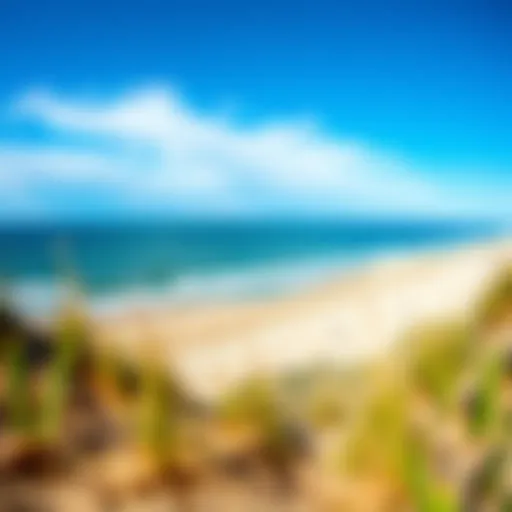Enhancing Kiteboarding with GoPro, Mounts, and Gimbals
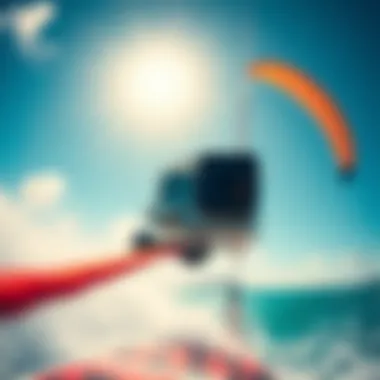
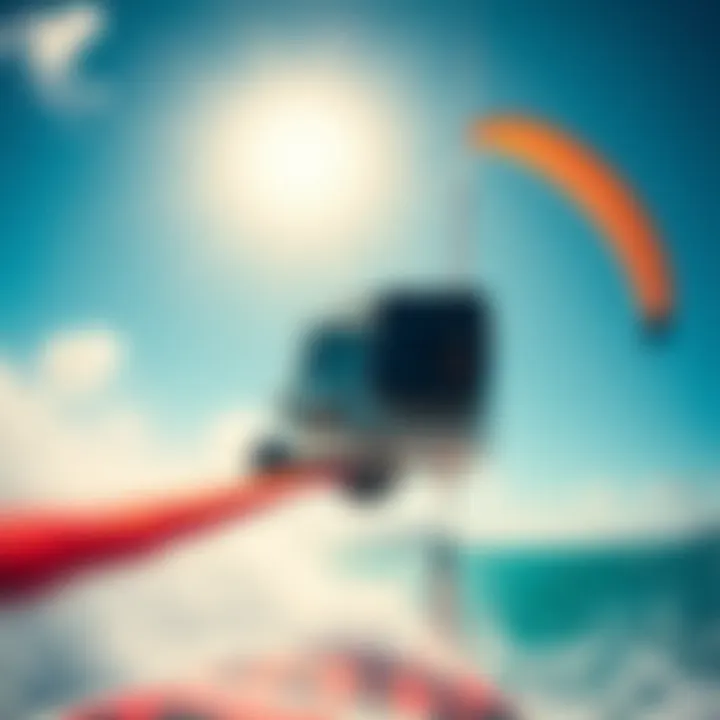
Intro
Kiteboarding is not just about riding the wind and waves; it's an exhilarating dance between nature and your spirit. Capturing those breathtaking moments can elevate the experience to new heights. Enter the world of GoPro cameras, kite line mounts, and gimbals. These are not merely gadgets; they form a trio that transforms the way kiteboarders document their adventures.
This article takes a deep dive into how these tools work in concert. From beginners to seasoned pros, there’s something valuable here for everyone. Whether you're looking to share your rides on social media or simply relive the thrill of a perfect session, understanding these devices is crucial.
The discussion will unfold in a structured manner, covering gear insights, techniques, and essential safety practices. Let’s get started on this journey!
Gear Insights
Latest Gear Reviews
The market is flooded with options when it comes to cameras and mounts. Not all products are created equal, so let's break down some of the latest offerings.
- GoPro Hero 10 Black: Recently launched, this camera boasts impressive stabilization features and 5.3K video quality. It's a game changer for those capturing fast-paced action.
- Kite Line Mounts: Brands like GoPro and others offer specific mounts designed for securely attaching cameras to your lines, allowing for stunning point-of-view shots. Look for options that are lightweight yet durable to withstand the rigors of kiteboarding.
- Gimbals: Products like the Zhiyun Smooth 4 gimbal are notable for their capabilities in stabilizing footage. While traditionally used for handheld devices, they can work well when attached creatively to your kite gear.
Essential Gear for Beginners
Starting out in kiteboarding can feel daunting, but the right gear makes all the difference. Here’s a quick rundown to get you going:
- Beginner Kite: Choose a kite that’s forgiving, preferably with a bigger surface area for easier lift.
- Control Bar: A reliable control bar is essential for steering and safety. It should fit comfortably in your hands.
- Safety Harness: Comfort is key here. A well-fitted harness allows you to ride without strain, especially when paired with a safety release mechanism.
- Helmet and Impact Vest: Safety gear cannot be understated. Protecting your head and torso from falls is a must.
- Camera Setup: A more compact GoPro model such as the Hero 9 can be a great starting point for capturing your initial flights. Pair it with a kite line mount that’s easy to install and adjust.
Techniques and Tips
Advanced Tricks and Techniques
Once you've got the basics down, it’s time to up your game. Incorporating your camera into your kiteboarding can create stunning visuals, especially when attempting advanced maneuvers. Here are a few popular moves:
- Backroll: Combine rotation and a jump to create a mesmerizing twirl in the air. Your GoPro will catch the entire motion beautifully.
- Kiteloop: This one takes practice but can produce astonishing footage. Looping your kite while in the air delivers both thrills and chills.
- S-Bend: For those looking for a challenge, this move involves transitioning from a jump into a flip and landing it back smoothly.
Safety Practices for Kiteboarders
Kiteboarding can be risky, so it’s essential to follow safety protocols:
- Pre-Flight Check: Inspect your gear before hitting the water. Look for wear and tear on lines, kites, and harnesses.
- Know Your Environment: Being aware of wind conditions and potential hazards is critical. Scouting your landing area beforehand can save you from nasty surprises.
- Buddy System: Always kite with a partner when possible. A second person ensures safety and can provide assistance if the need arises.
Remember, every seasoned kiteboarder started as a novice. Taking the time to understand your gear and techniques will pay off in the long run.
These tools, while they may seem technical, serve a greater purpose: enhancing your connection to the sport. Whether you're capturing your own jumps or just enjoying the view, understanding how to use these devices effectively can make a world of difference. Armed with this knowledge, you’re now ready to dive into the thrilling world of kiteboarding, equipped both physically and digitally!
For more gear reviews and kiteboarding tips, check out Wikipedia on Kiteboarding and discussions on the Kiteboarding subreddit.
Preface to Kiteboarding Technology
In the exhilarating world of kiteboarding, the technology we utilize plays a pivotal role in fueling our adventures. This article examines the intricate relationship between tools like GoPro cameras, kite line mounts, and gimbals. These devices not only amplify the excitement of the sport but also provide a means to capture those breathtaking moments for future enjoyment and sharing.
The advancement of kiteboarding technology, particularly in the realm of video capture and stabilization, has transformed how enthusiasts experience and remember their rides. Incorporating sophisticated tools allows both novices and seasoned kiteboarders to document their skills and journeys in stunning detail. Ensuring that the synergy between these tools is understood will enrich the user experience and elevate the quality of visual output.
The Evolution of Kiteboarding Gear
Kiteboarding itself has undergone significant changes since its inception. Early designs were rudimentary and often lacked consideration for aerodynamics and usability. As technology progressed, so did the sophistication of kite gear.
Modern kiteboards and kites are now engineered with lightweight materials and improved designs that allow for easier handling and aerial maneuvers. Furthermore, integrating equipment like GoPro or comparable action cameras into the setup has become standard practice.
Through innovations such as kite line mounts, kiteboarders can capture their stunts from unique angles, revealing perspectives that were previously unattainable. The ease of recording and sharing footage has contributed to a surge in kiteboarding's popularity, as the exhilarating moments can now be easily shared on various platforms like Reddit or Facebook, connecting kiteboarding communities worldwide.
Importance of Video Capture in Extreme Sports
In a sport as thrilling and visually captivating as kiteboarding, capturing the experience on film isn't just for bragging rights; it serves several vital functions. Video capture can provide valuable insights into technique and progression, offering players a way to assess their skills and identify areas for improvement.
- Skill Development: Reviewing footage allows kiteboarders to analyze their movements and make necessary adjustments.
- Creativity and Expression: Video enables surfacing artistic visions. Enthusiasts can create stunning edits that showcase their personal styles and journey.
- Community Building: Sharing videos fosters relationship-building within kiteboarding communities, often leading to collaborations and friendships through shared interests.
As kiteboarding grows in recognition as an extreme sport, the art of documenting one's journey has become almost as crucial as the ride itself. Being able to relive those highs and lows, caught on camera, adds layers to the experience, ultimately connecting individuals through passion.
Understanding GoPro Cameras
In the realm of kiteboarding, selecting the right camera can significantly impact how riders capture their experiences. GoPro cameras have been at the forefront of adventure filming technology, making them a top choice for kiteboarders. Their compact design and rugged build are tailored to withstand the elements, providing reliable footage in harsh conditions. This section focuses on the essential features that make GoPro an ideal companion on the water and also compares various models to guide users in making informed choices.


Features that Enhance Kiteboarding Filming
GoPro cameras are equipped with features that elevate the quality of kiteboarding footage. Here are some notable attributes that stand out:
- High Resolution and Frame Rates: GoPro cameras offer stunning resolutions up to 4K, which allow for beautifully detailed videos. High frame rates enable slow-motion captures, perfect for showcasing thrilling tricks.
- Waterproof Design: No need for bulky cases; many GoPro models come waterproof right out of the box. This durability means riders like to take them directly into the waves without worrying about damage.
- Wide-Angle Lens: The wide field of view captures more action, giving viewers a broader perspective of the athlete's movements and the surrounding environment.
- Built-in Stabilization: Advanced stabilization technology minimizes shaky footage, making even the roughest rides appear smooth. This is crucial when you’re flying over water at high speeds or navigating gusty winds.
- Voice Control: Hands-free operation is a game changer. Kiteboarders can start recording or adjusting settings simply by using their voice, allowing them to focus on the action rather than fiddling with the camera.
Understanding these features can help riders make the most of their GoPro when capturing their sessions, ensuring they get clear, professional-quality videos that highlight their skills.
Comparison of Different GoPro Models
When diving into the world of GoPro, it’s beneficial to know which models are best suited for your shooting style. The models vary widely in terms of specifications and price. Here’s a brief look at some popular options:
- GoPro Hero11 Black: The latest model comes packed with top-notch features, powerful image stabilization, and fantastic low-light performance. Ideal for professionals wanting the best quality.
- GoPro Hero10 Black: Almost as capable as the Hero11, it offers incredible video quality and fast processing speeds. A solid option for serious enthusiasts.
- GoPro MAX: This model breaks the mold by offering 360-degree filming capabilities. It’s a unique choice for those looking to capture every angle with one shot. Perfect for showcasing the full experience of kiteboarding.
- GoPro Hero9 Black: This budget-friendly choice does not skimp on quality. With impressive performance in video recording, it remains a popular option for newcomers who are serious about capturing their kiteboarding adventures.
Each of these models brings something unique to the table. Understanding the differences can help potential buyers select a GoPro that aligns with their kiteboarding style and filming needs. The flexibility of GoPro cameras makes them essential for anyone who wishes to document their kiteboarding exploits with clarity and flair.
"Investing in the right GoPro model can turn every ride into a cinematic adventure showcasing your love for kiteboarding."
For more in-depth features and comparisons, you may refer to resources like GoPro's official site or Wikimedia for historical context.
Kite Line Mounts Explained
Kite line mounts play a crucial role in capturing the essence of kiteboarding. By securing cameras directly to the lines of the kite, these mounts provide a unique perspective that standard ground-level filming cannot achieve. They allow kiteboarders to document their adventures from an entirely new angle, showcasing not just the action but also the aerial environment.
These mounts are designed for stability and flexibility, ensuring that the camera remains secure while also minimizing the effects of vibrations caused by the wind and rapid movement. This makes it easier to capture smooth footage, turning what might be a shaky ride into a visually appealing video.
Types of Kite Line Mounts
When it comes to kite line mounts, there are several versions tailored to suit different needs and preferences. Some common types include:
- Standard Kite Line Mounts: These mounts attach directly to the kite lines and are typically adjustable, allowing for various angles and positions.
- Flaring Mounts: Designed to protrude outwards, these can capture a broader field of view while minimizing obstruction from the kite itself.
- Low-Profile Mounts: These sit closer to the lines and reduce drag, making them an excellent choice for more speed-oriented kiteboarding styles.
Each type of mount offers different advantages and might be preferred depending on the intended filming style or the desired filming angle.
How to Properly Install a Kite Line Mount
Installing a kite line mount may seem straightforward, but it’s important to get it right for both safety and quality. Here’s a simple step-by-step guide:
- Select the Mount: Choose the right type of kite line mount for your filming needs.
- Prepare the Lines: Make sure your kite lines are clean and free from knots or obstructive debris.
- Attach the Mount: Secure the mount to the lines, ensuring it’s firmly fastened to avoid any movement during flights.
- Align the Camera: Adjust the camera angle as desired, and double-check that it is positioned correctly for optimal footage capture.
- Test Run: Conduct a short flight to see how the mount performs, making adjustments if necessary.
Following these steps will help ensure not only stable filming but also a secure installation that won’t endanger your equipment during intense kiteboarding sessions.
Safety Considerations with Kite Line Mounts
Safety cannot be overlooked when using kite line mounts, both for the rider and for others nearby. Here are some considerations:
- Secure Attachment: Always check the mount before taking off. An insecure mount could become detached and pose a hazard.
- Avoid Congested Areas: Kiteboarding often occurs in public spaces. Ensure that your setup does not endanger bystanders or other kiteboarders.
- Check Local Regulations: Be aware of any rules regarding drone or camera usage in public areas; certain locations may have restrictions.
- Use Quality Gear: Investing in high-quality mounts and camera equipment is crucial to prevent failures.
By taking these precautions, both your kiteboarding experience and filming can be enjoyable and safe.
The synergy of GoPro, kite line mounts, and gimbals can transform how kiteboarding is experienced and documented, making each session a potential masterpiece.
The Role of Gimbals in Kiteboarding
When talking about kiteboarding, there’s a potent synergy between capturing action and stabilizing footage, and that’s where gimbals come into play. Understanding how gimbals can make or break the viewing experience is essential for anyone looking to document their kiteboarding escapades effectively. Gimbals help mitigate the natural fluctuations and shakes that come with riding, and they do so with impressive precision. It’s one thing to glide along the water, and a whole different game to record that seamlessly for others to enjoy.
What is a Gimbal and Why Use One?
At its core, a gimbal is a pivoted support that allows the rotation of an object about a single axis. In essence, it stabilizes your camera, keeping it steady even when your body moves like a cork in a storm. This feature becomes remarkably beneficial in kiteboarding, where winds, waves, and movements act as relentless adversaries to smooth footage.
When kiteboarding, you’re often gliding over choppy seas and soaring into the sky. Capturing that with a handheld camera results in a lot of shaky footage – trust me, no one wants to watch a roller coaster ride from a camera’s perspective! A gimbal counteracts this by dynamically adjusting to your movements, so the audience can enjoy crisp, stable footage. Without it, your recorded thrill can come out looking more like a bumpy ride through an amusement park rather than the artistic display of skills you envision.
Gimbal Features Beneficial for Action Sports
Not all gimbals are created equal, especially when it comes to the rigors of action sports like kiteboarding. Here’s a list of features to look for:
- 3-Axis Stabilization: This feature is vital. It accounts for pitch, roll, and yaw movements, ensuring that even if you twist and turn, your footage stays smooth.
- Water Resistance: Kiteboarding is an aquatic sport. Thus, gimbals designed for such activities should be water-resistant, or better yet, waterproof.
- Compact and Lightweight Design: The last thing you need while kiteboarding is extra weight. A gimbal should be lightweight to not hinder your performance.
- Battery Life and Charging Options: Being away from shore means you might not have easy access to power. Opt for gimbals with long battery life and the ability to swap batteries quickly.
- User-Friendly Controls: Intuitive controls help when you need to make quick adjustments on the fly. You want to pilot your kite, not struggle with fiddly buttons!
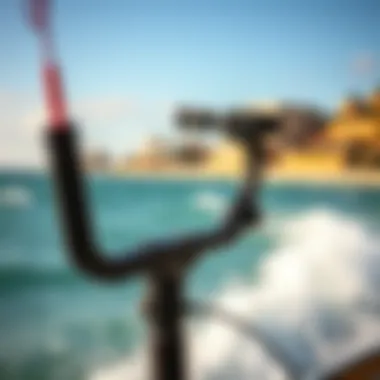
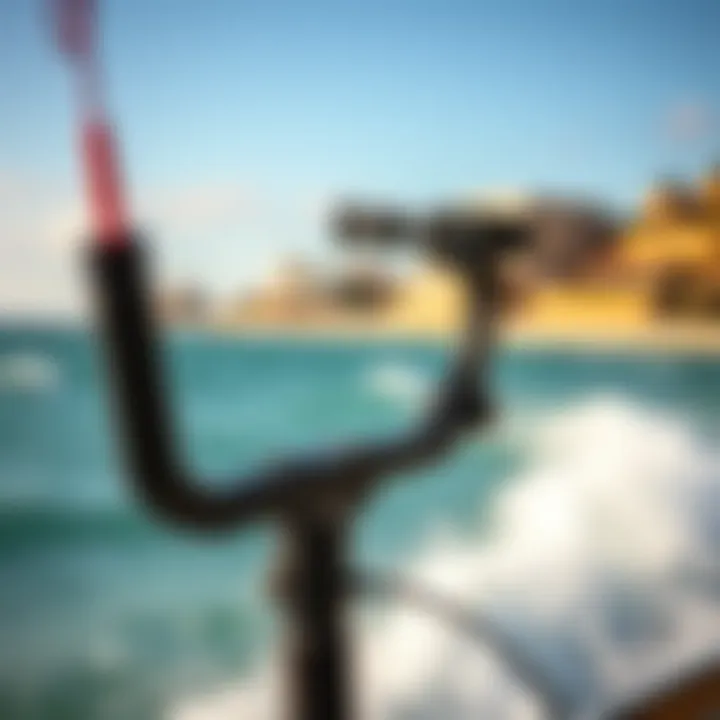
Ultimately, using a gimbal in kiteboarding allows riders to document their activity authentically and attractively. Not only does it up the ante in terms of production quality, but it also opens doors for adventures to be shared confidently with potential viewers. Being able to take a moment and share it beautifully can resonate deeply in the sporting community.
"A well-stabilized shot reveals the magic of kiteboarding like nothing else; it’s not just about the ride; it’s about how that ride is viewed."
Using a gimbal transforms the footage you capture from something often shaky into a seamless representation of your kiteboarding experience. Consequently, understanding gimbal technology becomes an essential part of your kiteboarding journey. Whether you are a novice or seasoned professional, incorporating a gimbal into your setup ensures that your thrill rides are well-documented for posterity.
Combining GoPro with Kite Line Mounts and Gimbals
In the vibrant world of kiteboarding, the combination of GoPro cameras, kite line mounts, and gimbals can elevate the entire experience for both riders and viewers. This trio works symbiotically—each component enhancing the others in ways that transform how these thrilling sports are filmed and enjoyed.
First off, using a GoPro on a kite line mount guarantees not just proximity to the action, but a perspective that is unique. Kiteboarding presents rapid movements and unpredictable conditions; combining a GoPro with a sturdy kite line mount allows for capturing dynamic shots that would be impossible otherwise. While one might think a traditional handheld setup or a drone could suffice, they simply can't replicate the point of view a rider experiences, which is raw and exhilarating. The vibrant colors of the water, the sensations of speed, and the rush of the wind all come together when capturing it from the right angle.
Moreover, gimbals play a crucial role in stabilizing footage. The excitement of kiteboarding often translates into shaky video, and the use of a gimbal can ensure that those breathtaking moments don’t lose their impact due to erratic camera movements. The combination of these tools doesn't just improve the quality of content—it enhances viewer engagement. Videos become smoother, more professional, inviting audiences to share in the thrill without even setting foot on a board.
"Creating captivating footage is not just about equipment, but how you use it. Combining GoPro, mounts, and gimbals can lead to a whole new level of storytelling in extreme sports."
Maximizing Stability and Quality of Footage
When capturing high-octane moments in kiteboarding, maximizing stability is essential. GoPro's compact design lends itself well to being mounted on a kite line, but without appropriate stabilization, even minor vibrations can result in a rocky viewing experience. Gimbals are the unsung heroes here. They work by balancing the camera, using motors to counteract any movements caused by the wind or the action of the kiteboarding itself.
Here’s why using a gimbal is a game-changer for kiteboarders:
- Smooth Footage: Gimbals can stabilize footage to an extent where it feels like a cinematic experience, making every jump and trick look professional.
- Adjustable Settings: Many gimbals allow riders to customize settings to match their specific movements, meaning you can tailor the stability control for different styles, such as freestyle or wave riding.
- User-Friendly: Even those new to kiteboarding cams can grasp the basics of operating a gimbal quickly, reducing the learning curve.
Achieving a perfect balance between the kite line mounts and gimbals will result in a crystal-clear view that enhances the art of filming kiteboarding drastically.
Innovative Techniques for Capturing Action
The synergy of GoPro, kite line mounts, and gimbals does not stop at merely stabilizing the footage. There's a whole world of innovative filming techniques that can be employed to capture the thrill of kiteboarding creatively.
- 360-Degree Perspectives: With a dual GoPro mount on the lines, riders can achieve stunning shots from multiple angles. Imagine flipping the perspective by utilizing a pair of cameras at different points, allowing viewers inside the action.
- Time-Lapse Sequences: Using GoPro’s time-lapse feature mounted securely can capture how conditions change throughout a session. This can highlight the rapid shifts in wind and light, giving a rich backdrop to the thrills of the day.
- Drone Synchronization: Although drone footage provides another level altogether, having a coordinated approach between a kite-mounted GoPro and a drone can create stunning visual storytelling. By synchronizing their movements, both perspectives combine seamlessly in post-production.
- Narrative Captures: Harnessing the unique perspectives created by these devices can tell a deeper story. For example, focusing on a rider's emotions, the setting sun’s reflection on the water or even the joy of flying high through the air can be delicately captured with the right tools.
Ultimately, merging practical techniques with the right equipment offers endless creative possibilities. Whether you are a seasoned professional kiteboarder or just starting, these methods can amplify your storytelling and bring your adventures to life differently.
Through understanding how to effectively combine these technologies, kiteboarders can significantly up their content game, ensuring their audience feels the wind beneath their feet and the adrenaline rush of each ride.
Practical Applications
In the world of kiteboarding, practical applications of video recording technology can truly elevate both the sport and the experience. Whether you’re a beginner just cutting your teeth on the waves or a seasoned pro catching air in competitions, knowing how to effectively use tools like GoPro cameras, kite line mounts, and gimbals can make a world of difference. It’s not just about capturing the action; it’s about telling a story, sharing experiences, and even analyzing performance.
One of the biggest advantages of using this tech synergy is the ability to film in unique angles and perspectives. For instance, a kite line mount allows for first-person perspectives that can immerse viewers in the action. Imagine the sensation of flying high above the waves, feeling the wind in your face, all while your camera captures the exact experience. This perspective can be particularly captivating for sharing content on social media or through personal vlogs.
Filming Techniques for Different Kiteboarding Styles
Filming techniques should vary according to the different styles seen in kiteboarding; each style presents its own narrative and aesthetic. Here’s how you can tailor your techniques:
- Freestyle: For this energetic style, fast-paced cuts coupled with close-up shots from your GoPro can capture the tricks and jumps. Using a gimbal for stabilization while filming can help in delivering smooth transitions even amidst the noise of the water.
- Wave Riding: Capture the serene yet dynamic nature of wave riding with longer, flowing shots. A kite line mount positioned to focus on the surfer’s movements can highlight the harmony between the rider and the waves.
- Race: If you’re into kiteboarding racing, focus on speed. GoPro’s high frame rates can help in depicting the fast-paced action. Using a drone to capture aerial shots of the racecourse adds excitement and context to the competition, creating a more engaging narrative.
"Taking the time to understand how to effectively capture your kiteboarding journey can not only enhance your own experience but also inspire others in the kiteboarding community."
Sharing Content: Platforms and Communities
Sharing your kiteboarding footage can be just as important as capturing it. Fortunately, several platforms can help amplify your reach in the kiteboarding community.
- YouTube: This is the go-to platform for in-depth content. Create tutorials or share your personal journey in kiteboarding while integrating your footage. Use compelling titles and descriptions to optimize for searches around kiteboarding films.
- Instagram: Perfect for bite-sized content, using short clips or stunning images can instantly catch the attention of fellow kiteboarders. Utilize the appropriate hashtags like #kiteboarding, #GoPro, and #wateradventure to boost visibility.
- Facebook Groups: Engaging in kiteboarding communities can provide a network of support and feedback. Share your experiences and gather insights from others who are equally passionate. Connections often lead to collaborations and learning opportunities.
Post-Production Considerations
The journey doesn’t end once you’ve wrapped up your kiteboarding session. Post-production plays a vital role in transforming your raw clips into stunning visual stories. Just like a good chef fine-tunes a dish after cooking, the same attention must be paid to video editing to ensure that your footage captures the essence of your adventure.
Editing Footage Captured with GoPro and Gimbals
Editing footage recorded using GoPro and gimbals can be likened to piecing together a jigsaw puzzle. Every shot you capture is a piece that can come together to tell a compelling story. Using editing software like Adobe Premiere Pro or Final Cut Pro can help a lot, but it’s not just about cutting and pasting clips.
- Cutting for Impact: When you sit down with your footage, focus on cutting the clips to maintain the audience's engagement. Random cuts may disrupt the flow of the video. Choose sections that showcase the best moments or the most exciting tricks.
- Color Grading: This can elevate your footage from "meh" to mesmerizing. Adjusting exposure, contrast, and saturation can make your colors pop, keeping the viewers visually invested.
- Audio Matters: Sound design can be just as important as visuals. Including music, ambient sounds, or voiceovers not only enhances the quality of your video but also establishes a connection with your audience.
- Transitions & Effects: Use transitions sparingly to keep it professional. Overusing fancy transitions can make your video feel cluttered and unpolished. Simple cuts, fades, or dissolves often suffice.
- Final Touches: Before hitting export, ensure to review your video for any jarring transitions or unintentional errors.
In the end, taking these steps in post-production can amplify the experience of your kiteboarding exploits, capturing not just the action but the very thrills associated with them.
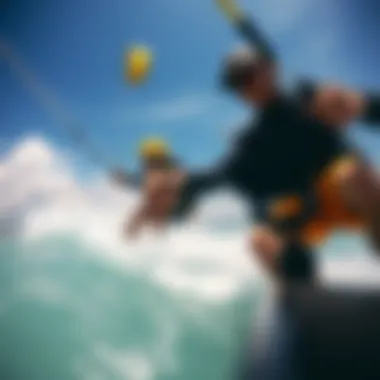
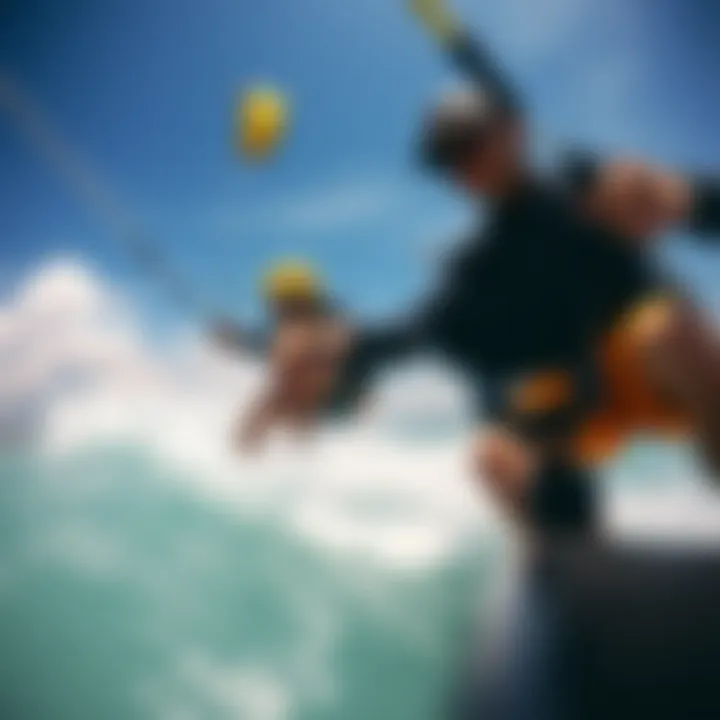
Tips for Enhancing Viewer Engagement
Creating engaging content is key to attracting an audience who’s as passionate about kiteboarding as you are. Here are a few strategies to boost engagement:
- Start Strong: The first few seconds are crucial. Grab attention with breathtaking shots, captivating music, or a quick sneak peek of the best moments ahead.
- Narrative Arc: Treat your video as a story. Have a clear beginning, middle, and end. Introduce the adventure, showcase the excitement, and wrap up with reflections or highlights that resonate with your audience.
- Calls to Action: Don’t shy away from prompting your viewers to engage. Phrases like "let me know your favorite trick in the comments" or "like and subscribe for more kiteboarding content" can cultivate a community around your work.
- Utilize Thumbnails and Titles Wisely: Creating eye-catching thumbnails and intriguing titles can significantly increase the likelihood of a viewer clicking on your video. Think of it as your video’s first impression.
While it may take time to hone these skills, remember that every video is an opportunity to grow and attract a loyal audience who shares your love for the adventure and thrill that kiteboarding brings.
Maintenance and Care
Maintaining your equipment in kiteboarding is as crucial as the actual sport itself. Proper care and maintenance not only extend the lifespan of your gear but also ensure that you capture every exhilarating moment while out on the water. GoPro cameras, kite line mounts, and gimbals are a significant investment, and treating them with care is essential for optimal performance. Here’s a closer look at what this entails.
Caring for Your GoPro and Accessories
To keep your GoPro camera in top shape, the first step is to ensure it’s always clean and free from salt and dirt. After a session on the water, wash your GoPro with fresh water. Salt build-up can damage sensitive components over time. Use a soft cloth to wipe the lens; this prevents scratches that could mar the footage.
Additionally, check the battery compartment and memory card slot for any debris and keep these areas dry. The housing is also vital – inspect it for cracks or wear, particularly if you've taken it on some rough rides. A functional housing keeps moisture at bay, so it’s not wise to overlook any concerns there.
Don't forget about your accessories like mounts and adapters; they too need attention. For instance, the adhesive pads on mounts can wear out, especially with changing temperatures. It’s wise to regularly check these and replace them if they start to fail.
In terms of storage, keeping your GoPro and its accessories in a cool, dry place away from direct sunlight will help prevent deterioration of batteries and plastic components.
Common Issues with Kite Line Mounts and Gimbals
When it comes to kite line mounts, common issues often arise from improper installation. If a mount isn’t correctly secured to the lines, the camera could shift mid-flight, affecting your shot quality. Double-check that the brackets and clips are securely fastened but not overly tightened, as this can lead to damage.
Gimbals, while fantastic for stabilizing your footage, can be quite temperamental if not correctly calibrated. Signs that your gimbal might be having issues include shaky footage or failure to stabilize. Make it a habit to calibrate the gimbal each time before you hit the beach; this simple step can save you hours of editing later. The battery of gimbals is another often overlooked area. Replace them regularly and keep an eye on performance; a weak battery can lead to erratic behavior.
Here are some common issues to be aware of:
- Mounting Failure: Always check that your mount is secure to avoid losing your camera.
- Calibration Problems: Regularly calibrate gimbals for smooth footage.
- Battery Shortage: Make sure your equipment has a full charge before heading out.
By being diligent in maintaining both your GoPro camera and its accessories, as well as monitoring potential issues with kite line mounts and gimbals, you ensure a more enjoyable and hassle-free kiteboarding experience. The right care equates to better footage and ultimately enhances your adventure.
Future Trends in Kiteboarding Filming Technology
Kiteboarding is rapidly evolving, and so are the technologies that enhance how we capture those breathtaking moments on the water. The future of kiteboarding filming technology promises to revolutionize the way enthusiasts document their escapades, offering advanced solutions that combine creativity, safety, and convenience. This section explores emerging innovations in action cameras and the increasing use of drones, both of which are reshaping the kiteboarding landscape.
Emerging Innovations in Action Cameras
The advent of high-performance action cameras has made documenting kiteboarding not just feasible, but a thrilling experience in itself. Advanced features like ultra-high-definition video, improved stabilization, and longer battery life have become essential for capturing action-packed scenes. It's not just about recording; it's about delivering quality footage that feels engaging to viewers.
Some key innovations to watch out for include:
- Improved Image Sensors: Enhancements in sensor technology are allowing cameras to perform better in various lighting conditions, which is critical for early mornings or late afternoons on the water.
- AI-driven Stabilization: Innovations in stabilization technology come with artificial intelligence that can analyze motion and adjust recordings in real time. This results in smoother footage, reducing the choppy effect that often detracts from the viewing experience.
- Live Streaming Capabilities: Today's action cameras are not just for recording; they are becoming tools for live broadcasting. Imagine sharing your kiteboarding exploits in real time with friends and followers.
- Modularity and Customization: Some brands are venturing into modular designs that allow users to customize their equipment based on the environment or their specific needs, setting the stage for a personalized filming experience.
Adopting these technologies can enhance not only the footage quality but also the storytelling aspect of kiteboarding adventures.
The Growth of Drone Usage in Extreme Sports
Drones are bringing a new dimension to kiteboarding filming, allowing for shots that were once impossible to achieve. They have become an invaluable tool for capturing sweeping aerial views and dynamic angles that can excite audiences and provide insights into the sport from above.
Benefits of integrating drones into kiteboarding filming include:
- Aerial Perspectives: Filming from above provides a unique vantage point of kiteboarding maneuvers, showing the full breadth of the sport's beauty.
- Track and Follow Modes: Many modern drones come with features that enable them to autonomously follow a rider, ensuring continuous coverage without the drone operator needing to maneuver the drone constantly.
- Enhanced Safety Protocols: With the right regulations in place, drones can maintain safety while capturing footage in areas that may be off-limits for land filming, maximizing the opportunities for incredible shots.
As drone technology becomes more accessible and refined, its integration into kiteboarding filming will soar, making it possible for both amateurs and pros to elevate their storytelling through aerial cinematography.
In coming years, kiteboarding enthusiasts can expect to see exciting advancements that will profoundly influence how they share their experiences, both on the water and in the midst of their communities.
Epilogue
The journey through the integration of GoPro cameras, kite line mounts, and gimbals in kiteboarding reveals more than just a collection of tech tools; it showcases a profound shift in how kiteboarders can capture and share their experiences. The impact of this technology on kiteboarding is multifaceted, touching both the practical and emotional aspects of the sport.
The Impact of Camera Technology on Kiteboarding
With every session on the water, the gear you choose has the potential to radically transform your experience. Gone are the days where kiteboarding was merely a thrill; now it’s a visually compelling adventure that can be recorded with precision and artistry using GoPro cameras. These cameras allow kiteboarders to document their ride from various angles, providing unique perspectives that were previously difficult to capture.
Camera technology has left no stone unturned in terms of enhancing the way kiteboarders engage with their surroundings. Here’s how:
- Perspective: The ability to mount these cameras on kite lines allows for breathtaking perspective shots. It captures the rider's leap into the air or the splash of the board hitting the water—moments that define the thrill of kiteboarding.
- Stability: When paired with a gimbal, footage remains smooth despite the chaotic nature of the sport. No one enjoys watching shaky videos of their thrilling rides. Gimbals help ensure that content creators deliver polished visuals.
- Safety: Filming kiteboarding experiences has also increased awareness around safety practices. With the right technology, riders can analyze their performance, leading to improvements and a reduced risk of accidents.
- Connection: The ability to share these experiences on platforms like YouTube or Instagram has created a community among kiteboarders. It builds camaraderie and inspires others to take part in the sport.
"The best stories are often captured in the moments where you feel most alive. Technology has made it easier to turn those moments into lasting memories for yourself and the world to see."
In light of these considerations, the merging of technology into kiteboarding serves not only to document but also to enrich the experience of intense engagement with the sport. The synergy between GoPro, kite line mounts, and gimbals provides kiteboarders with tools that enhance not only their moments on the water but also how they share those experiences with the broader world. Embracing these technologies opens up avenues for creativity, connection, and skill development, making it an essential aspect of modern kiteboarding.



